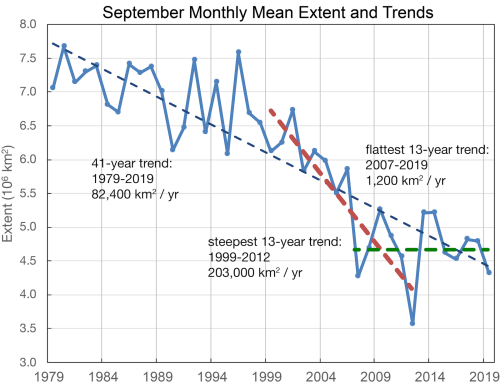By Tyler Durden
Why Are Polar Bears Going Extinct? (Spoiler Alert: They're Not!)
Via Dr. Susan Crockford's PolarBearScience.com,
Google says many people ask this question so here is the correct answer: polar bears are not going extinct.
If you have been told that, you have misunderstood or have been misinformed. Polar bears are well-distributed across their available habitat and population numbers are high (officially 22,000-31,000 at 2015 but likely closer to 26,000-58,000 at 2018): these are features of a healthy, thriving species.
‘Why are polar bears going extinct?’ contains a false premise – there is no need to ask ‘why’ when the ‘polar bears [are] going extinct’ part is not true.
It is true that in 2007, it was predicted that polar bear numbers would plummet when summer sea ice declined to 42% of 1979 levels for 8 out of 10 years (anticipated to occur by 2050) and extinct or nearly so by 2100 (Amstrup et al. 2007). However, summer sea ice has been at ‘mid-century-like’ levels since 2007 (with year to year variation, see NOAA ice chart below) yet polar bear numbers have increased since 2005. The anticipated disaster did not occur but many people still believe it did because the media and some researchers still give that impression.
The prediction of imminent extinction of the polar bear was an utter failure, as I’ve shown in this scientific paper (Crockford 2017) and my most recent book, The Polar Bear Catastrophe That Never Happened.
Examine the evidence and you will see that claims of polar bears going extinct are simply not true. So far, the response of polar bears to recent ice loss suggests that they will continue to thrive with even less summer ice than there has been in recent years as long as ice in winter (December-March) and spring (April-June) remains reasonably abundant, as has been the case to date. The most recent information available is summarized in the upcoming State of the Polar Bear Report 2019, to be released 27 February 2020 but see also the 2018 report (Crockford 2019b).
The graph below was constructed by NASA sea ice expert Walt Meier and published by the US National Snow and Ice Data Center in early October 2019. It shows clearly that summer sea ice (measured as the average for September) has not declined further since 2007 but has had a flat trend.
The graph below is from my book and shows the growth of global polar bear numbers since the 1960s.
The final estimate 26,000-58,000 or 39,000 average) is my plausible and scientifically defensible ‘best guess’ based on extrapolation of recent survey results, summarized here and explained in detail in my book.
FOOTNOTE
One of Google’s top ‘suggestion’ when I search for the term ‘polar bear’ is a list of questions that people supposedly ask the most (‘People also ask’), including ‘Why are polar bears going extinct?’
The ‘answer’ provided is not an actual answer but a statement from WWF, an multi-national organization financially invested in promoting the idea that polar bears are suffering due to declining sea ice: it’s paid Google advertising meant to look like answers and facts:
‘Because of ongoing and potential loss of their sea ice habitat resulting from climate change, polar bears were listed as a threatened species in the US under the Endangered Species Act in May 2008. The survival and the protection of the polar bear habitat are urgent issues for WWF.’
Note the statement misleadingly says ‘sea ice’ when it really means ‘summer sea ice’ – the predictions of potential polar bear population decline were based exclusively on summer ice (Amstrup et al. 2007; Crockford 2017, 2019).
As I said above, ‘Why are polar bears going extinct?’ contains a false premise – there is no need to ask ‘why’, when the ‘polar bears [are] going extinct’ part is not true. This post is for the people who search the internet thinking that polar bears really are going extinct.
Another question Google offers is: ‘How many polar bears are left?’ Answer [my bold]:
‘In fact, the World Wide Fund for Nature (or WWF) estimates that there are only 22,000 to 31,000 polar bears left in the world. Jan 25, 2019’
Only? This global estimate, provided by the IUCN Red List (not the WWF) means there are almost three times more polar bears than the 10,000 or so there were in 1960 (Regehr et al. 2016; Wiig et al. 2015). But the Red List figure includes out-of-date estimates and low-balled guesses for many of the 19 subpopulations and my book (Crockford 2019) explains why this 2015 estimate sanctioned by the IUCN was almost certainly too low.
February 29, 2020 at 06:15AM
via ZeroHedge News https://ift.tt/32zuIG2




Comments
Post a Comment